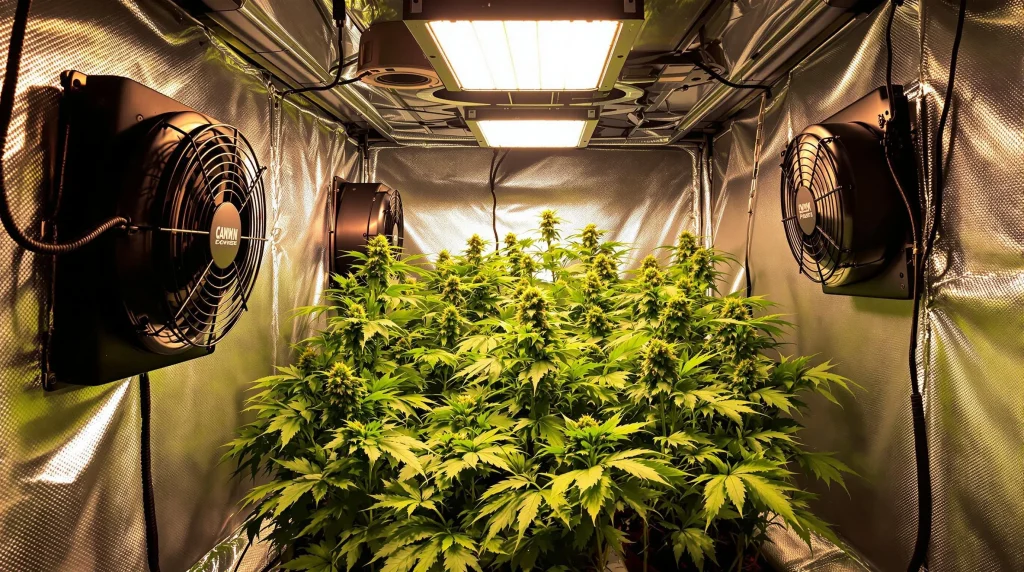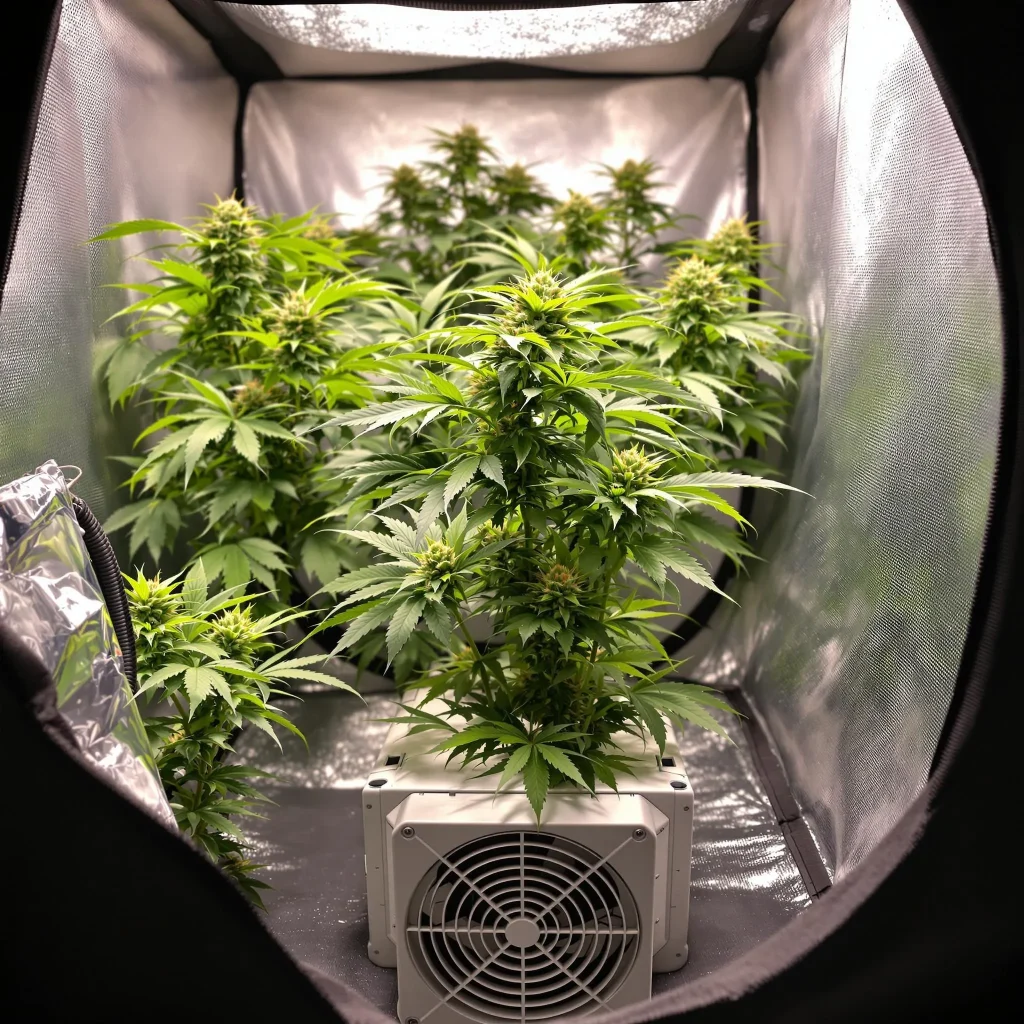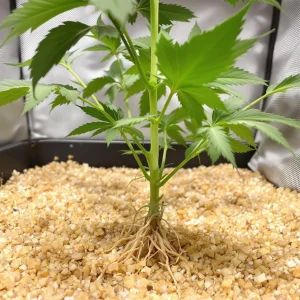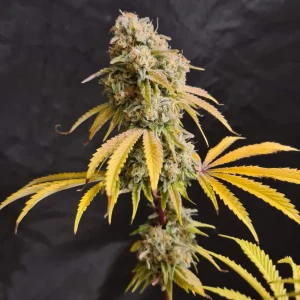Why Ventilation is Essential for Grow Tents
The Importance of Air Circulation in Plant Growth
Do I need intake fan for grow tent? Proper ventilation is the backbone of a successful grow tent setup. Cannabis plants thrive when they receive a continuous supply of fresh air. Air circulation ensures that carbon dioxide, an essential component of photosynthesis, reaches every part of the plant. Without adequate airflow, plant growth slows, and yields suffer.
Stale air can also lead to uneven nutrient uptake, resulting in weaker plants. With effective ventilation, you create an environment where your cannabis plants can grow robustly and produce high-quality buds.
Preventing Heat and Humidity Issues
Grow tents often house powerful grow lights, which generate significant heat. Without a system to manage this heat, temperatures can rise to harmful levels. High humidity caused by stagnant air further increases the risk of mold and mildew, which can devastate your crop.For additional control over moisture levels, explore our guide on dehumidifiers for grow tents to keep your environment optimal.
An intake fan works by pulling in fresh air from outside the tent, replacing hot, humid air with cooler, drier air. This constant exchange maintains optimal temperature and humidity levels, keeping your cannabis plants healthy and thriving.
Supporting Healthy Plant Development with Proper Airflow
Good airflow strengthens cannabis plants by mimicking natural outdoor conditions. As air moves around your grow tent, it gently rustles the plants, encouraging stronger stems and branches. This resilience is crucial for supporting heavy buds during the flowering stage.
In addition, proper airflow prevents hot spots and ensures even light distribution, giving every plant an equal chance to flourish. An intake fan plays a key role in maintaining this balanced environment.

What is an Intake Fan and How Does it Work?
Understanding the Role of Intake Fans in Grow Tents
An intake fan is a device designed to pull fresh air into your grow tent. This air replenishes oxygen levels, supplies carbon dioxide for photosynthesis, and helps regulate temperature and humidity.
In cannabis cultivation, intake fans work in tandem with exhaust fans. While the exhaust fan removes stale, warm air, the intake fan ensures a constant supply of fresh air. This creates a dynamic airflow system that supports vigorous plant growth.
Passive vs. Active Intake Fans: What’s the Difference?
Passive intake relies on openings in the grow tent to allow air to flow in naturally. This method works well for small tents with low heat output but may struggle to maintain ideal conditions in larger setups.
Active intake uses a dedicated intake fan to draw air into the tent. This method provides greater control over airflow and is essential for larger grow spaces or setups with high-powered lights.
Benefits of Using an Intake Fan for Cannabis Cultivation
Adding an intake fan to your grow tent improves air quality, reduces temperature fluctuations, and enhances humidity control. This creates an optimal environment for cannabis plants to absorb nutrients, grow stronger, and produce higher yields.
For growers dealing with challenging climates or struggling with heat and humidity, an intake fan is a game-changing tool for maintaining consistent conditions.
Do You Really Need an Intake Fan for Your Grow Tent?
Factors to Consider Before Adding an Intake Fan
Whether you need an intake fan for your grow tent depends on several factors, including the size of your setup, the type of grow lights you use, and the climate in your grow space.
If your tent is small and your lights produce minimal heat, passive intake might suffice. However, larger tents or setups with high-intensity lights often require active intake fans to manage airflow effectively.
Another consideration is the external environment. If your grow space is located in a hot or humid area, an intake fan can help maintain stable conditions inside the tent.
When Passive Intake is Sufficient
For small grow tents with low heat output, passive intake may work well. Simply opening vents or using mesh-covered openings allows fresh air to flow in as the exhaust fan expels stale air.
This setup can save energy and costs but may struggle to keep up with the demands of larger grows or high-powered equipment. Monitoring temperature and humidity levels is crucial to ensure passive intake meets your plants’ needs.
Scenarios Where an Active Intake Fan is Essential
An active intake fan becomes necessary when passive systems can’t maintain optimal conditions. Larger grow tents, setups with multiple lights, or environments with poor natural ventilation benefit significantly from active intake.
An intake fan ensures a steady flow of fresh air, preventing heat buildup and providing consistent CO2 for photosynthesis. If you notice uneven growth, sluggish plants, or temperature spikes, adding an intake fan could be the solution.
How to Set Up an Intake Fan in a Grow Tent
Choosing the Right Intake Fan for Your Setup
Selecting the correct intake fan involves considering your grow tent size and the airflow requirements of your setup. Look for fans with adjustable speed settings to tailor airflow to your plants’ needs.
For most grow tents, fans with a cubic feet per minute (CFM) rating that matches or slightly exceeds the tent’s volume work best. Higher CFM ratings are ideal for larger spaces or setups with high heat output.
Proper Placement of Intake Fans for Maximum Efficiency
Position your intake fan near the bottom of the grow tent, where cooler air can enter. This placement complements exhaust fans, which are typically located at the top to remove warm air.
Ensure the fan directs air evenly across the tent. Avoid obstructing airflow with plants or equipment, as this can create hot spots or reduce ventilation effectiveness.
Adjusting Fan Speed and Direction for Optimal Airflow
Fine-tune your intake fan’s speed to match the needs of your grow environment. Too much airflow can stress plants, while too little can lead to stagnant air.
Consider using oscillating fans alongside your intake system to distribute air evenly. This setup ensures every plant receives the fresh air it needs to thrive.
Benefits of Using an Intake Fan in Your Grow Tent
Maintaining Ideal Temperature and Humidity Levels
One of the primary benefits of an intake fan is its ability to stabilize temperature and humidity. Cannabis plants thrive within specific ranges, and fluctuations can cause stress, affecting growth and yield.
An intake fan pulls in cooler, fresh air to offset the heat generated by grow lights. This consistent airflow helps maintain a balanced environment, reducing the risk of heat stress or excessive humidity that can lead to mold and mildew.
Reducing Mold and Pest Risks
Stagnant air creates the perfect breeding ground for mold, mildew, and pests. An intake fan keeps the air moving, disrupting the conditions these threats need to thrive.
By improving air circulation, you minimize the chances of fungal infections like powdery mildew and deter pests such as spider mites. Healthier plants mean higher-quality cannabis at harvest time.
Improving Plant Growth and Yield with Enhanced Ventilation
Effective ventilation supports robust plant growth by ensuring each cannabis plant receives the carbon dioxide it needs for photosynthesis. The constant exchange of fresh air promotes nutrient uptake and encourages stronger, more resilient plants.
When your grow tent maintains consistent airflow, your cannabis plants can focus their energy on producing dense buds rich in cannabinoids and terpenes. An intake fan plays a critical role in achieving these superior results.
Best Strains to Grow with Optimal Ventilation
Pairing high-quality strains with an efficient ventilation system, including an intake fan, ensures healthy growth and superior yields. Here are four exceptional cannabis strains that thrive in well-ventilated grow tents:
Ice Cream Cake
Ice Cream Cake is an indica-dominant strain known for its sweet, creamy flavor and potent effects. This strain flourishes in controlled environments with proper airflow, which helps maintain its dense, resin-coated buds. The right ventilation reduces humidity, preventing mold and enhancing the terpene profile, ensuring its signature aroma shines.
Shiskaberry
Shiskaberry is a flavorful indica with a fruity, berry-like aroma and relaxing effects. It thrives in environments with consistent temperature and humidity levels. An intake fan helps maintain these conditions, promoting vigorous growth and maximizing the yield of its compact, colorful buds.
LSD Auto
LSD Auto is an autoflowering hybrid famous for its potent effects and ease of growth. This strain prefers stable environments with fresh air circulation, which supports its rapid growth cycle. Proper ventilation ensures even development and enhances the production of its sticky, psychoactive flowers.
Hollands Hope
Hollands Hope is a hardy indica strain bred for outdoor and indoor cultivation. It benefits from excellent airflow in grow tents, which prevents the dense foliage from trapping excess moisture. This robust strain produces large, resinous buds that thrive with proper ventilation and airflow.
These strains showcase the importance of ventilation in achieving optimal growth and quality. Pairing your chosen strains with an intake fan ensures a healthy environment, allowing your plants to reach their full potential.

FAQs About Intake Fans in Grow Tents
Can I Use a Grow Tent Without an Intake Fan?
Yes, you can use a grow tent without an intake fan, especially if you have a small setup or effective passive intake. However, for larger tents or setups with high-powered lights, an intake fan is often necessary to maintain optimal conditions.
If you notice uneven growth, high temperatures, or poor air quality, adding an intake fan can resolve these issues and improve your plants’ overall health.
How Much Airflow Does My Grow Tent Need?
The amount of airflow your grow tent needs depends on its size. Calculate the tent’s volume (length × width × height) and select an intake fan with a cubic feet per minute (CFM) rating that matches or slightly exceeds this number.
For example, a 4x4x6 tent has a volume of 96 cubic feet. Choose an intake fan with a CFM of 100 or more to ensure proper ventilation.
What Size Intake Fan is Best for My Grow Tent?
The best intake fan size for your grow tent depends on the tent’s dimensions and your specific setup. Smaller tents may only require a 4-inch fan, while larger setups benefit from 6-inch or 8-inch models.
Consider factors like the power of your grow lights, the external climate, and the presence of an exhaust system when selecting your intake fan. Matching the fan size to your tent’s needs ensures efficient airflow and optimal plant growth.





